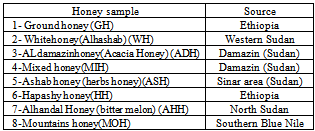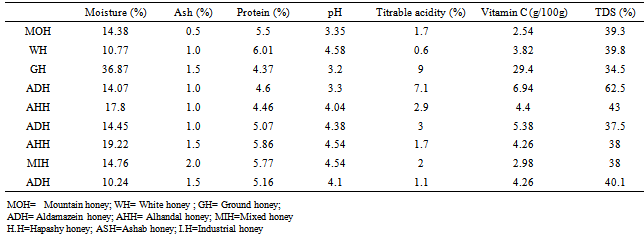-
Paper Information
- Next Paper
- Previous Paper
- Paper Submission
-
Journal Information
- About This Journal
- Editorial Board
- Current Issue
- Archive
- Author Guidelines
- Contact Us
Food and Public Health
p-ISSN: 2162-9412 e-ISSN: 2162-8440
2013; 3(3): 137-141
doi:10.5923/j.fph.20130303.04
Quality Evaluation of Honey Obtained from Different Sources
Abdel Moneim E. Sulieman1, Banan A. Abdelhmied2, Zakaria A. Salih2
1Department of Biology, Faculty of Science, University of Hail, Hail, Kingdom of Saudi Arabia
2Department of Food Science and Technology, Faculty of Engineering and Technology, University of Gezira , Wad Medani, Sudan
Correspondence to: Abdel Moneim E. Sulieman, Department of Biology, Faculty of Science, University of Hail, Hail, Kingdom of Saudi Arabia.
| Email: |  |
Copyright © 2012 Scientific & Academic Publishing. All Rights Reserved.
Honey is a food rich in nutrients essential for human life such as sugars, proteins, vitamins and minerals and uses honey as food and medicine. Honey is considered one of the most foods which can be adulterated, therefore this study aimed to assess the quality of different samples of natural and industrial honey and matching the results with the international standards. Chemical and physical methods were used in the study to determine the various chemical and physicochemical characteristics. For determination of sugars, a High Performance Liquid Chromatography (HPLC) was used. The results indicate that there were no significant differences in most of the chemical and physicochemical characteristics of natural honey and industrial honey. The results also indicated that the various honey types contained sucrose (10.7%-3.48%), fructose (14.74% - 39.01%), glucose (14.09% - 35. 6%). However, the industrial honey was the richest type in nutrients, so its use in industry is highly recommended.
Keywords: Sugars, Minerals, Ascorbic Acid, Total Dissolve Solids, Acidity
Cite this paper: Abdel Moneim E. Sulieman, Banan A. Abdelhmied, Zakaria A. Salih, Quality Evaluation of Honey Obtained from Different Sources, Food and Public Health, Vol. 3 No. 3, 2013, pp. 137-141. doi: 10.5923/j.fph.20130303.04.
Article Outline
1. Introduction
- Honey is a natural food, mainly composed of a complex mixture of carbohydrates and other minor substances, such as organic acids, amino acids, proteins, minerals, and vitamins. In almost all honey types, fructose predominates, glucose being the second main sugar. These two account for nearly 85–95% of the honey carbohydrates. More complex sugars made up of two or more molecules of glucose and fructose constitute the remaining carbohydrates, except for a trace of polysaccharide. Honey also contains volatile substances which are responsible for the characteristic flavour. The Codex Alimentarius Standard for honey quality includes several chemical and physical parameters, comprising moisture content, mineral content, acidity, hydroxymethyl furfural (HMF) content, diastase activity, apparent sugar content, and water insoluble solids content. These analyses help the food analyst to determine the “chemical” quality of the honeys analyzed. Moreover, suggest that they may be used in association with multivariate analyses to assign floral origin. The honey analyses conductive pH free acidity and percentages of fructose, glucose and raffinose as variables for the principal component analysis[1].The composition and properties of a particular honey sample depend strongly on the type of flowers the bees visited, on the climatic conditions in which the plants grow and on the beekeeper's contribution. From the chemical point of view, honey is a highly complex, concentrated mixture of sugars with a large pool of minor constituents of different molecular weights (MW) and chemical nature embedded. Many of these components are thought to be responsible for its beneficial properties, from high-MW components (proteins) excreted by honey bees into honey (e.g. glucose oxidase, invertase, saccharase, diastase and catalase) and, to peculiar and particularly abundant plant secondary metabolites (e.g. kynurenic acid (KA) in chestnut honey , cyclohexa-1,3-diene-1-carboxylic acid (CDCA) in lime tree honey, and/or an array of minor compounds (phenolic acid derivatives such as ferulic acid, caffeic acid and coumaric acid and its esters, and flavonoid aglycones) deriving from the original composition of the nectars and sugar-rich materials on which honey bees feed to produce honey[2].In 2005, China, Argentina, Turkey and the United States were the top producers of natural honey. Significant regional producers of honey include Turkey (ranked third worldwide) and Ukraine (ranked fifth worldwide). Mexico is also an important producer of honey, providing about 10% of the world's supply. However, the data on honey in African countries especially, is scanty. Therefore the main objectives of the study were to assess quality of honey samples collected from different sources. And to compare the quality parameters of honey with the international standards.
2. Material and Methods
2.1. Collection of Honey Samples
- Nine samples were obtained from local producers. The botanical origin of the honey samples was shown in Table ( 1).
|
2.2. Physicochemical Characteristics
- For determination of acidity in different honey samples, 10 grams of homogenized honey will be weigh a glass beaker, 75 ml of water were added, and this solution was titrated with carbonate-free 0.10 NaOH until the pH reached 8.5. For pH measurement pH-meter (PHS-3C Digital) was used at ambient temperature[3].Total dissolve solids (TDS) of honey samples was measured using Conductivimeter. The Conductivimeter was adjusted with standard buffer solution. 50ml of sample were taken in beaker, and then read directly by conductivimeter [3].
2.3. Proximate Chemical Analysis of Honey
- The moisture, ash and proteins contents of honey samples were determined according to AOAC[4] methods.
2.4. Determination of Sugars Content
- High performance liquid chromatography (HPLC, Shamadzu-Japan)) was used for determination of sugars content in the various samples of honey which was operated according to the following conditions:Mobile phase: Autonitrite 75%, water : 25%, flow rate : 1ml/min., detector: reteractive index, RID- 10A, stationary phase: Column: shodex Asahipak, NH2P – 50 4E and injection volume: 10µlIn the process, 1 g of sample was taken and diluted with water, the mixture was introduced to ultra some water bath to aid solubility then the sample was filtered through membrane filter 0.45µm.10µl of filtrate was injected in HPLC system
2.5. Ascorbic Acid (Vitamin C)
- Ascorbic acid content in the various samples was determined according to the AOAC[4], in which: 30 g of sample were blended with reasonable amount of 0.4 oxalic acid for 1 minute, aliquot was transferred to 500 ml volumetric flask, made up to volume with 0.4 oxalic acid and was filtered through No. 4 whatman filter paper. Then 20 ml aliquot were pipetted and titrated against the dye solution to faint pink end point. Ascorbic acid content was calculated according to the following formula:

2.6. Determination of Minerals
- Mineral contents were determined according to the AOAC[5] method. In this method the contents of Ca, P, Na, K, Fe, Zn, Cl, and Mn were determined.
3. Results and Results
3.1. Physicochemical and Approximate Chemical Characteristics of Honey
|
3.2. Sugar analysis Using HPLC for Sugar Content
- The sugar composition can be determined by different chromatographic methods[14]. HPLC being the most widely used one. As for the types and quantities of sugar found in honey which were analyzed using a device HPLC, the results are shown in Table (3). The Mountain honey had the highest percentage of glucose (35.0%), while the highest percentage of fructose was found in Aldamazain honey (39.01%). On the other hand, the Ground honey had the lowest value of both glucose (14.1%) and fructose (14.8%) which contained no any sucrose, therefore, the taste of Ground honey was bitter. In contrast, the Industrial honey contained the highest percentage of sucrose (10.7%), so this type of honey is not suitable for diabetic patients. On the other hand, sucrose was not found in many of the examined types of honey such as Ground honey, Hapashy honey, White honey and Aldamazein honey, these results are higher than those of the USA Standards[15] which indicted that honey the contains glucose (31.3%), fructose (38.2%) and sucrose (1.3%). However, White[16] determined a value of 38.2 and 31.8 fructose, 31.3 and 26.1, 0.7 and 0.5 fructose, glucose and fructose in Blossom honey and Honeydew honey, respectively. Generally, three basic types of sugars were found in the present study: glucose, sucrose and fructose which were found in varying amounts. However, there are types of sugars were not determined or found in only small amounts such as raffinose , maltose and dextrose. It has been reported that Sugars are the main constituents of honey, comprising about 95 % of honey dry weight. Main sugars are the monosaccharides hexoses fructose and glucose, which are products of the hydrolysis of the disaccharide sucrose. Besides, about 25 different sugars have been detected[9];[17].
|
|
3.3. Minerals Content
- Table (4) shows that the percentage of Ca, P, Na, K, Fe, Zn, Cl, and Mn ranged between 0.35% - 0.2% , 0.2% -0.1%, 0.7% -0.54% , 2.3% - 1.2% , 0.87% - 0.7% , 0.105% - 0.089% , Cl 0.205% - 0.11% and 0.099% - 0.08%, respectively. Honey is richer in minerals, that render it unsuitable for winter stores. The results of the present study were in agreement with the findings of Mohamed and Babikr[18] who indicated that K (74.6 mg/kg), Na (28.2 mg/kg) , P (204.6) mg/kg and S(131.5) mg/kg , Ca (82.92 mg/kg), Mn (1.019 mg/kg), Fe (2.05 mg/kg), Zn (9.61 mg/kg) were found in honey. Honey contains varying amounts of mineral substances ranging from 0.02 to 1.03 g/100 g (White, 1975). The main element found in honey is potassium, besides many other elements. Several investigations have shown that the trace element content of honey depends mainly on the botanical origin of honey[19] ; [20]. It was possible to differentiate between different unifloral honeys by determination of different trace elements by measuring Mg, Ca, Al, Fe, Mn, Zn, B, Cu, Co, Cr, Ni, Cd and P[14];[21].
4. Conclusions
- In this study eight different samples of natural honey were analyzed chemically and physically and compared with the industrial honey. The chemical analysis indicated that Ground honey contained the highest contents of moisture, while Hapashi honey contained the highest contents of ash. On the other hand, the percentage of protein was highly varied, the highest content was found in white honey and the lowest was in the ground honey. It can be mentioned that honey is the acidic in nature since the examined pH of all types of honey was less than 7. The highest percentage of vitamin C was found in ground honey while the highest and lowest TDS% were found in Aldamazain honey and the ground honey, respectively. As for the types and quantities of sugars, different types of sugars were found in honey samples. The highest contents of glucose was found in White honey, while the highest contents of fructose was found in Aldamazain honey, however, small quantities of sucrose were found in some samples and absent in others. Many minerals were found in the honey samples, such as sodium, potassium, phosphorus, iron, chlorine, manganese, zinc and calcium.Generally, there are no significant differences in most of the chemical components of natural honey and industrial honey. It is highly recommended to incorporate honey into the food and bakery products, and to find simple ways to detect adulterated honey and to find the laws governing the standard of quantities and ingredients naturally present in honey.
ACKNOWLEDGEMENTS
- The authors would like to express their sincere gratitude for the staff of the Department of Food Science and Technology, Gezira University their unlimitted assistance during the research implementation.
 Abstract
Abstract Reference
Reference Full-Text PDF
Full-Text PDF Full-text HTML
Full-text HTML


